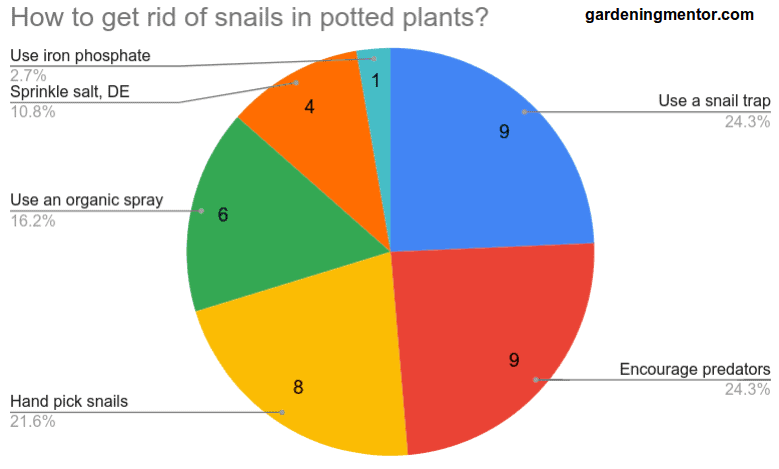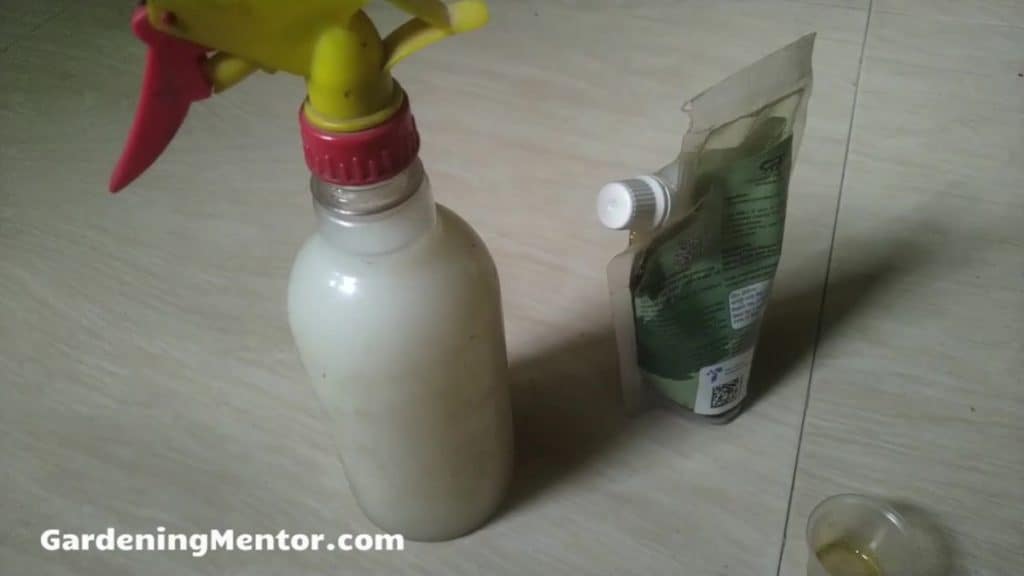So you have started growing some potted plants and having fun with gardening. But you noticed some snails have started to get into the pots.
Snails are bad for potted plants because they eat up the leaves, flowers, and fruits on the plant. You need to either hand pick and dispose them. Or use a beer trap to get rid of them. They multiple quickly so you need to take care of them fast.
I’ll show you some methods to help you get rid of the snails and prevent them from coming back into your potted plants.
How do you tell if snails are eating my plants?
You can tell if snails are eating your plants by looking at the leaves. They will be eaten at the edges in a jagged manner.
You will also be able to see the silver trails of slime left by the snails near the potted plant.
Why are there snails in my potted plants?
There are snails in your potted plants because they find it a source of food. The snails will eat almost any plant but are most attracted to edible ones such as cabbage, tomato, and lettuce.
The snails will be in your potted plants because they find it moist and cool inside the container with the potting soil.
How to get rid of snails in potted plants?
I conducted a survey with my fellow gardeners on what methods they prefer to get rid of snails in plants and below are the results. Most gardeners prefer to use a snail trap, encourage predators, or handpick them.

1. Pick the snails out of the potted plants
The simplest method is to pick the snails out of the potted plants and dump them in a bucket of soapy water.
But that does mean you need to touch the snails. So you may not prefer this method if you’re squeamish. You can use a pair of gardening gloves if that helps you catch the snails.
You may also need to check your potted plants at night because that’s when the snails tend to be most active and come out to eat.
2. Sprinkle organic materials that harm snails
There are plenty of organic materials you can use to get rid of snails from the potted plant. You can find some of them in your house while some you can buy from a nursery or garden center.
You may need to use these materials several times to get rid of all the snails in your potted plants. They will also get washed away after you water the plants or there is rainfall.
Salt
Salt is the easiest material you can find and use to get rid of snails. Sprinkle some on the snails and it will kill them. If you don’t want to sprinkle salt directly onto the snails, put some salt around where you think the snails might hide.
The only problem with salt is too much of it will harm your plants so you need to be careful. The salt will cause dehydration in plants as they take in less water.
Be careful with salt. It can kill plants. You never want to put salt into your beds or containers. – Charley
Eggshells
Eggshells are another material you can use to get rid of snails. You need to crush them into a fine powder before using it in your potted plants. The tiny pieces will cut through the snail’s body and slowly kill it. But you will need to spread a lot of the eggshell powder and it will take some time.
Diatomaceous earth
It’s much better to use diatomaceous earth that has the same effect but is much faster. This is a fine powder made from the fossilized remains of sea microorganisms.
The fragments of this material have sharp edges that cut through the snails’ bodies and cause them to dehydrate. They will slowly die as a result.
3. Use a spray that will kill the snails
You can make a spray using common house ingredients that can help get rid of snails from your potted plants. This includes things like vinegar, soap, coffee, and even garlic.
Before you use this spray, I want to warn you not to spray this on your plants. This can act as a herbicide and damage them. Make sure only to spray it on the snails.
You can start by mixing 1 part white vinegar and 1 part water in a spray bottle. Spray this on the snails and check if it’s effective. If it does not work, you need to increase the vinegar concentration the next time.
Garlic spray can repel beneficial insects as well so be careful you spray it only on the snails.
You can crush 3 cloves of garlic together with 1 tablespoon of vegetable oil. Leave this mixture for 24 hours and then strain it in 4 cups of water. Add 1 teaspoon of dish soap into this solution and mix well.
You can now take this solution in a spray bottle and spray it on the snails to kill them.
Coffee spray
A strong spray of coffee will kill snails but you need to be careful not to spray it on the plants as it’s very acidic.
You need to brew the coffee with water so that the caffeine concentration is at least 1-2% so that it is effective against the snails.
Then add it to a spray bottle and spray it on the snails in your potted plants.

Research has found that a 1-2% caffeine solution will kill snails, while coffee grounds will simply form a barrier snails do not like to cross. (smithspestmanagement.com)
Soapy water spray
Soapy water works well to dissolve the protective layer of snails and kill them. You can add 2 tablespoons of dish soap to a gallon of water and mix them up well.
Add the solution to a spray bottle and spray it on the snails to get rid of them. Ensure not to spray on the foliage as the soap water will burn the leaves if it comes under sunlight.
You can add 1 teaspoon of baking soda and 5-6 drops of dish soap to a cup of water. Mix it up well and add it to a spray bottle.
Spraying this solution on the snails in the potted plants should help get rid of them.
You can mix 1 part alcohol (70%) with 1 part water to create an alcohol spray. Put it in a spray bottle and spray it on the snails to get rid of them.
The alcohol will also help get rid of some other pests that may be present on your potted plants.
4. Use a trap to catch the snails
Snails are attracted to beer so you can use that as a trap to catch them. You need a deep container that you fill up with beer.
Place this container in the location near the plants where you find snails often visit. Ensure to put the container into the ground or soil so that just 1-inch of the container is above the ground.
The snails will come to drink the beer, fall into the container, and not be able to get out. You can throw the trapped snails away in the morning and refill the container to catch some more.
5. Feed the snails to kill them
You can use iron phosphate to feed the snails and kill them over time. The snails enjoy eating this material but over time it messes up their appetite and the snails will die due to starvation.
This method will take some time so if you have a large snail infestation you may try the other options to get rid of them faster.
6. Encourage predators that eat snails in the garden
If you’re growing the potted plants outdoors, you can attract birds and animals that prefer to eat the snails. Frogs, toads, snakes, blackbirds, bluebirds, and robins are some of them.
You could even raise some chickens or ducks that would love to get rid of the snails for you.
I carefully kidnap the hedgehogs that wander in front of my house to relocate them in my garden. – Pendora
How do I keep snails out of my potted plants?
Once you have gotten rid of snails in your potted plants, you can use some methods so they don’t come back again.
Many of these methods use some materials that snails don’t like so they don’t come near the potted plants.
Sprinkle some organic materials to keep snails away
The same organic materials that you used to get rid of snails can be used to keep them away. This includes salt, crushed eggshells, diatomaceous earth, and coffee grounds.
Snails don’t like salt or coffee grounds because it is toxic to them. Materials such as crushed eggshells and diatomaceous earth have sharp microscopic materials that cut the snails and dehydrate them.
You can sprinkle salt near the pot to prevent the snails. But don’t put it in the potting soil as salt will dehydrate the plants.
You can sprinkle crushed eggshells and coffee grounds in the potting soil near the plant. These will keep the snails away as well as add calcium and nitrogen to the soil.
You can sprinkle the diatomaceous earth powder on the potting soil as well as the foliage to keep snails and other scaly pests away from your potted plants.
Place some protective materials near the potted plant
You can use some materials that will help repel snails from your potted plants. This includes copper, sandpaper, and petroleum jelly.
The snails feel a slight shock when they touch the copper and avoid the material. So you can either place a ring of copper coins around the plant or you can stick copper tape around the container.
Surrounding the container with very coarse sandpaper will also prevent the snails from reaching the plant as they find it uncomfortable moving through the material.
You can smear petroleum jelly on the outer edge of the container and near the base. The snails won’t be able to move through the petroleum jelly and reach your potted plant.
Grow some plants that repel snails from your potted plants
Snails will attack and eat most plants especially edible ones. But there are some plants that snails tend to stay away from.
You can grow these plants together with your potted plants and they will repel the snails. These protective plants tend to have a strong odor that keeps snails away.
Some of these plants include herbs like thyme, lavender, rosemary, and sage. Some other plants include daylilies, fennel, salvia, onion, and garlic.
Can plants recover from slug and snail damage?
Yes, plants can recover from slug and snail damage if there are still sufficient leaves on the plant. If the slugs and snails have eaten most of the leaves, then the plant will not survive.
Remove all the slugs and snails from the plant that still has some leaves left. Provide the required water and sunlight to the plant. I would not suggest adding fertilizer to the plant when it’s recovering.
This would stress the plant and cause more damage. You can add fertilizer once the plant has fully recovered and is healthy.

Fact Checked, Written, and Published by Kevin Rodrigues
Kevin is the founder of Gardening Mentor, a website that aims to teach people to grow their own food in a limited space. As a self-taught gardener, Kevin has spent several years growing plants and creating gardening content on the website. He is certified in Home Horticulture and Organic Gardening from Oregon State University. He has a Post Graduate Diploma in Horticulture and Landscape Gardening from Mumbai University.
Read more
